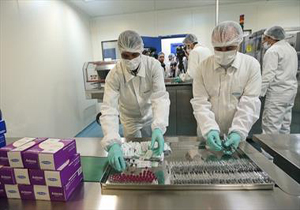صنعت داروسازی و بهداشت در ایران- سه ماهه 2015
BMI Industry View
BMI View: BMI continues to adjust its forecasts for Iran's pharmaceutical market to account for the sanction-induced currency crisis and high rates of inflation. The rapid depreciation of the rial means that we expect the value of the market to contract sharply in US dollar terms. While improved international relations have reduced the regulatory risk associated with operating in the market for multinational drugmakers, the recent proclamation of the Islamic State (IS) in neighbouring Iraq and Syria increases the threat of political instability.

Headline Expenditure Projections
■ Pharmaceuticals: IRR44,216bn (USD2.46bn) in 2013 to IRR51,684bn (USD1.63bn) in 2014; +16.9% in local currency terms and -33.9% in US dollar terms.
■ Healthcare: IRR548,672bn (USD16.63bn) in 2013 to IRR617,190bn (USD19.41bn) in 2014; +12.5% in local currency terms and +16.7% in US dollar terms.
Risk/Reward Index
BMI considers Iran's business environment to be slightly less appealing than the previous quarter, with a score of 41.5 out of 100 in Q115, unchanged from the previous quarter. Due to reappraisals of the scores of other countries, Iran's position in the regional rankings improved three places in the regional rankings to 14th out of 30 countries in the Middle East and Africa in Q115. Its overall score is below the regional average of 42.3. Generally speaking, Iran benefits from a large and growing population and relatively widespread access to healthcare services. However, its regulatory regime - including intellectual property (IP) rights, political and economic situation - is highly questionable. Consequently, the country performs above the regional average for potential rewards and below the regional average in terms of risk.
Key Trends And Developments
■ In October 2014, India-based generic drugmaker Cipla signed an agreement with its existing Iranian distributor to set up a manufacturing facility in Iran, according to a stock market disclosure.
■ Iran's pharmaceutical supply crisis is over according to Deputy Minister of Health and Chairman of the Food and Drug Administration Rasul Dinarvand. After having faced challenges from price volatility and drug shortages in 2013, the Islamic Republic News Agency reports that drug prices are now under control and customs clearance on imported medicine has resulted in an adequate supply of drugs.
BMI Economic View:
The Iranian economy will expand modestly over the coming years, and we project real GDP growth of 2.8% and 2.9% in 2014 and 2015, respectively. This compares with our estimate of a 2.9% contraction in 2013. Foreign direct investment by Western companies will remain minimal next year owing to the failure to reach a breakthrough in talks on the nuclear programme.
BMI Political View:
We believe that talks between Iran and the P5+1 countries (the US, Russia, China, France, Britain and Germany) on the Islamic Republic's nuclear programme will continue through 2015 and 2016. We see minimal scope for reaching a 'permanent' agreement - which would ensure Iran cannot use its enrichment activities to produce a nuclear weapon before the West can intervene - before the expiry of a deadline set for November 24 2014. Risks of reaching a final deal over the coming decade are tilted slightly to the downside owing to significant political obstacles.
گزارش تحلیلی بیزینس مانیتور- صنعت داروسازی و بهداشت در ایران- سه ماهه 2015

